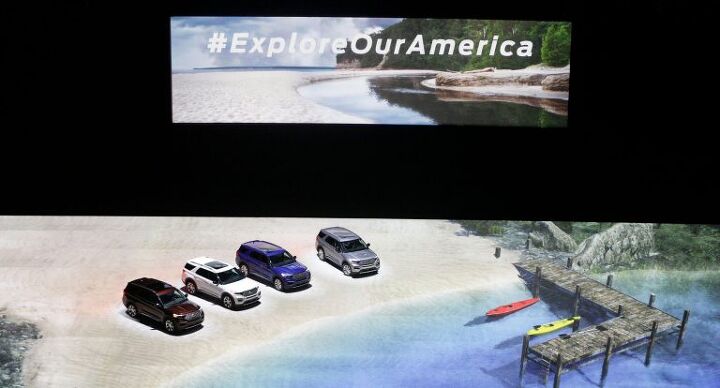2020 Ford Explorer: Now Rear-drive, This SUV Aims to Blend In
Wednesday night, Ford pulled the wraps off its all-new 2020 Explorer at an event held, quite appropriately, at Detroit’s Ford Field. The model is a complete redesign of America’s all-time best-selling SUV.
Since the introduction of the original, Ranger-based Explorer, over eight million units have found American homes. With that heritage in mind, the 2020 Explorer adopts a rear-wheel drive platform for the first time in a decade, with more attention paid to power, space, and capability. At the same time, Ford added new technology to assist owners who’ve managed to escape the daily grind.
The theme of Ford’s 2020 Explorer reveal was the “Great American Road Trip” (and fulfilling one’s One of Ford Field’s end zones, normally occupied by Bears and Vikings, was turned into a high tech video screen full of 3D wizardry.
A video of various Ford families discussing what road trips mean to them was the lead-in to a new Explorer driving on a graphical representation of America the Beautiful. Cue Ford CEO Jim Hackett and Executive Vice President Jim Farley…
While Ford redesigned the 2020 Ford Explorer from the ground up, you might not know it after just a passing glance. The design is clearly more evolutionary than revolutionary. If you were to place the new Explorer next to the previous generation, the average consumer would have no idea which one is rear-wheel drive. The new model features carryover design cues like angled C-pillars, blacked out A-pillars and D-pillars, plus that Land Rover-like look America seems to love. The grille is now bigger and more pronounced, while the longer wheelbase and longitudinally mounted engine improves the Explorer’s proportions.
Underneath, the 2020 Explorer’s new architecture led to a more athletic stance and what Ford claims is improved on- and off-road handling. A new engine lineup features a pair of EcoBoost entries – a 2.3-liter turbocharged four-cylinder that’s standard kit on base, XLT and Limited models, and a 3.0-liter twin-turbocharged V6 powering the Explorer Platinum. These engines send their power through Ford’s soon-to-be-ubiquitous 10-speed automatic transmission. The 2.3-liter engine is projected to produce 300 horsepower and 310 lb-ft of torque, while the 3.0-liter engine is estimated at 365 horsepower and 380 lb-ft. Two other powertrains, earmarked for Explorer Hybrid and Explorer ST, will be announced at a later date.
In terms of capability, the new Explorer sees an increase in tow ratings. Vehicles equipped with a 3.0-liter EcoBoost can tow up to 5,600 pounds, a 12 percent increase over outgoing models with the 3.5-liter EcoBoost. New models outfitted with a 2.3-liter EcoBoost and Class III Trailer Tow Package can tow up to 5,300 pounds (versus the 3,000 pounds in today’s similarly equipped model).
Inside, Ford recrafted the Explorer’s cabin with more space and technology. The first thing you’ll notice is the available 10.1-inch touch screen mounted in portrait configuration. This screen uses capacitive glass, like most smartphones, providing quicker response times and features like pinch zoom and screen customization. A more traditional 8-inch touchscreen comes standard on lesser trims. Both feature the Ford Sync3 infotainment system.
The tech onslaught doesn’t stop there. An available wireless charging pad allows customers to juice up compatible mobile devices, while up to four USB ports, including new type-C outlets, provide power for next-generation mobile devices. Up to three 12-volt outlets and a 110-volt outlet are also available. 2020 Explorers also offer an available 980-watt, 14-speaker B&O premium audio system.
One of the biggest additions to the new SUV is Ford’s Co-Pilot 360 suite, offered as standard equipment. This bundle of safety technologies includes Pre-Collision Assists with Automatic Emergency Braking, Blind Spot Information System with Cross Traffic Alerts, a lane keeping system, a rear-view camera with built-in lens cleaner, and auto headlamps with auto high-beams. Despite all of this being standard, the base Explorer’s price only increases around $400.
Ford’s betting on utilities and trucks in a big way. The Explorer is Ford’s first completely revamped utility since the company announced the cull of all cars not bearing the Mustang name, and it’s hard to image the 2020 Explorer not continuing the historic nameplate’s sales success. It’s a new product in a familiar package, packed with features SUV buyers want.
Manufactured at Ford’s Chicago Assembly Plant, the 2020 Explorer appears in showrooms this summer. While pricing won’t be be announced until a later date, the company wanted everyone to know the model’s starting point: $32,765.
[Images: Adam Tonge/TTAC]
More by Adam Tonge
Latest Car Reviews
Read moreLatest Product Reviews
Read moreRecent Comments
- Master Baiter I told my wife that rather than buying my 13YO son a car when he turns 16, we'd be better off just having him take Lyft everywhere he needs to go. She laughed off the idea, but between the cost of insurance and an extra vehicle, I'd wager that Lyft would be a cheaper option, and safer for the kid as well.
- Master Baiter Toyota and Honda have sufficient brand equity and manufacturing expertise that they could switch to producing EVs if and when they determine it's necessary based on market realities. If you know how to build cars, then designing one around an EV drive train is trivial for a company the size of Toyota or Honda. By waiting it out, these companies can take advantage of supply chains being developed around batteries and electric motors, while avoiding short term losses like Ford is experiencing. Regarding hybrids, personally I don't do enough city driving to warrant the expense and complexity of a system essentially designed to recover braking energy.
- Urlik You missed the point. The Feds haven’t changed child labor laws so it is still illegal under Federal law. No state has changed their law so that it goes against a Federal child labor hazardous order like working in a slaughter house either.
- Plaincraig 1975 Mercury Cougar with the 460 four barrel. My dad bought it new and removed all the pollution control stuff and did a lot of upgrades to the engine (450hp). I got to use it from 1986 to 1991 when I got my Eclipse GSX. The payments and insurance for a 3000GT were going to be too much. No tickets no accidents so far in my many years and miles.My sister learned on a 76 LTD with the 350 two barrel then a Ford Escort but she has tickets (speeding but she has contacts so they get dismissed or fine and no points) and accidents (none her fault)
- Namesakeone If I were the parent of a teenage daughter, I would want her in an H1 Hummer. It would be big enough to protect her in a crash, too big for her to afford the fuel (and thus keep her home), big enough to intimidate her in a parallel-parking situation (and thus keep her home), and the transmission tunnel would prevent backseat sex.If I were the parent of a teenage son, I would want him to have, for his first wheeled transportation...a ride-on lawnmower. For obvious reasons.





































Comments
Join the conversation
What timing! My sister is looking to replace her 2011 Explorer, and we didn't add the current Explorer as it was "too much of the same" as what she has, but the new one may make the list, which currently includes the Ascent, Highlander, Edge(ST) and "maybe" sneaking in the RDX.
While I'm sure the fancy turbochargers do a fine job of getting this overstuffed whale through the EPA testing process, much like in the F150, I'd wager a simple N/A V8 (possibly with cylinder deactivation) would provide nearly equivalent real world MPG and probably better reliability.